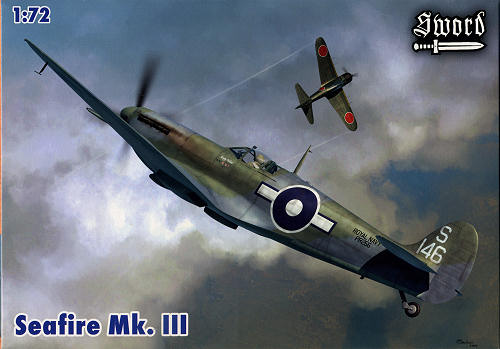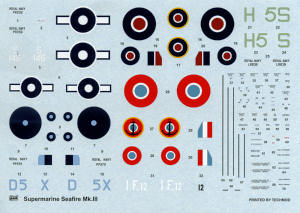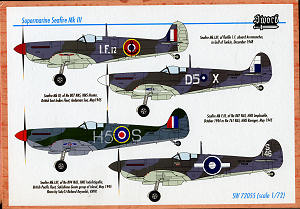
| KIT #: | SW72055 |
| PRICE: | $32.95 SRP |
| DECALS: | Four options |
| REVIEWER: | Scott Van Aken |
| NOTES: | Multi-media kit with resin parts |

| HISTORY |
The Seafire F Mk III was the first true carrier adaptation of the Spitfire design. It was developed from the Seafire Mk IIC, but incorporated manually folding wings allowing more of these aircraft to be spotted on deck or in the hangars below. Supermarine devised a system of two straight chordwise folds; a break was introduced immediately outboard of the wheel-wells from which the wing hinged upwards and slightly angled towards the fuselage. A second hinge at each wingtip join allowed the tips to fold down (when the wings were folded the wingtips were folded outwards). This version used the more powerful Merlin 55 (F Mk III and FR Mk III) or Merlin 55M (L Mk III), driving the same four-bladed propeller unit used by the IIC series; the Merlin 55M was another version of the Merlin for maximum performance at low altitude. Other modifications that were made on the Spitfire made their way to the Seafire as well including a slim Aero-Vee air filter and six-stack ejector type exhausts. The shorter barreled, lightweight Hispano Mk V cannon were introduced during production as were overload fuel tank fittings in the wings This Mark was built in larger numbers than any other Seafire variant; of the 1,220 manufactured Westland built 870 and Cunliffe Owen 350. In 1947 12 Mk IIIs were stripped of their naval equipment by Supermarine and delivered to the Irish Air Corps.
The first use of Seafires in carrier operations was Operation Torch. Seafires saw most service in the Far East Pacific campaigns, serving with No. 887 and 894 Squadrons, Fleet Air Arm, aboard HMS Indefatigable and joining the British Pacific Fleet late in 1944. Due to their good high altitude performance and lack of ordnance-carrying capabilities (compared to the Hellcats and Corsairs of the Fleet) the Seafires were allocated the vital defensive duties of Combat Air Patrol (CAP) over the fleet. Seafires were thus heavily involved in countering the kamikaze attacks during the Iwo Jima landings and beyond. The Seafires' best day was 15 August 1945, shooting down eight attacking aircraft for one loss. During the campaign 887 NAS claimed 12 kills and 894 NAS claimed 10 kills (with two more claims earlier in 1944 over Norway).
The top scoring Seafire pilot of the war was Sub-Lieutenant R.H. Reynolds DSC of 894, who claimed 4.5 air victories in 1944–5.
| THE KIT |
 Sword's
Seafire III is quite typical of their recent releases. The molding is very good
with fine engraved panel work. There are ejector towers on all the major pieces
with some requiring removal prior to assembly in order to get parts to fit. This
kit is obviously part of multiple boxings as there are separate fuselage and
equipment sprues to go along with a truncated main sprue. There are parts on the
main sprue that are not appropriate to this boxing so those can go in the spares
bin. The kit comes with a clear sprue that includes a one-piece canopy, gunsight and a couple of other small pieces. Resin is limited to exhaust.
Sword's
Seafire III is quite typical of their recent releases. The molding is very good
with fine engraved panel work. There are ejector towers on all the major pieces
with some requiring removal prior to assembly in order to get parts to fit. This
kit is obviously part of multiple boxings as there are separate fuselage and
equipment sprues to go along with a truncated main sprue. There are parts on the
main sprue that are not appropriate to this boxing so those can go in the spares
bin. The kit comes with a clear sprue that includes a one-piece canopy, gunsight and a couple of other small pieces. Resin is limited to exhaust.
The kit's cockpit is nicely done with well represented detail molded in the fuselage walls along with a rather detailed interior molding that includes seat, bulkheads, stick, O2 bottles and a nice floor with rudder pedals molded in place. A section of armor plate with head rest goes behind the seat.
For the wings, there are sections to box in the wheel wells. Landing gear has separate oleo scissors and the gear doors for both main and tailwheel are separate. There is a choice of either five spoked wheels or those with flat wheel covers. The prop is a one piece molding unlike the earlier Seafire 17 that was previewed. The exhaust pipes fit into a cutout in the forward fuselage that has no backing. It may be wise to install a piece of plastic card behind this opening if you plan to install the exhaust after painting the airframe.
 Instructions
are well done with generic color references and indications as to what to paint
the small
bits during construction. The decal sheet provides markings for four options.
One is a post war F
Instructions
are well done with generic color references and indications as to what to paint
the small
bits during construction. The decal sheet provides markings for four options.
One is a post war F rench
aircraft from aboard the Arromanches in 1948. Next is an 807 NAS aircraft from
HMS Humber in the Andaman Sea during May of 1945. This and the final option are
in standard FAA camo. The third options is from late 1944 aboard the HMS
Implacable with 877 NAS. This one has what looks like a standard RAF camo scheme
but without the yellow leading edges of the wings.Finally, from 894 NAS is this
plane from aboard the HMS Indominable during May of 1945 from the Sakishima
Gunto islands and flown by the highest scoring Seafire pilot, Richard Reynolds. A full
stencil suite is provided and the instructions have an excellent placement
guide. The decals are superbly printed by Techmod.
rench
aircraft from aboard the Arromanches in 1948. Next is an 807 NAS aircraft from
HMS Humber in the Andaman Sea during May of 1945. This and the final option are
in standard FAA camo. The third options is from late 1944 aboard the HMS
Implacable with 877 NAS. This one has what looks like a standard RAF camo scheme
but without the yellow leading edges of the wings.Finally, from 894 NAS is this
plane from aboard the HMS Indominable during May of 1945 from the Sakishima
Gunto islands and flown by the highest scoring Seafire pilot, Richard Reynolds. A full
stencil suite is provided and the instructions have an excellent placement
guide. The decals are superbly printed by Techmod.
| CONCLUSIONS |
This one should please all but the un-pleasable as it offers a nice kit with a very nice selection of markings. It is a kit that will look great on the shelf with the rest of the Supermarine crowd.
| REFERENCES |
http://en.wikipedia.org/wiki/Supermarine_Seafire
April 2012
Thanks to Squadron Products for the preview kit. Get yours today at your local shop or on-line retailer
If you would like your product reviewed fairly and fairly quickly, please contact the editor or see other details in the Note to Contributors.